Spondylosis, also known as spinal osteoarthritis, is a degenerative condition that affects the spine. It is a common ailment, particularly among older individuals, and can cause pain, stiffness, and reduced mobility. This article aims to provide an overview of spondylosis, including its causes, symptoms, and available treatment options.
What is Spondylosis? Spondylosis refers to the degeneration of the spinal structures, including the intervertebral discs, facet joints, and ligaments. This degeneration is primarily associated with age-related wear and tear on the spine, leading to the breakdown of cartilage and the formation of bone spurs (osteophytes) on the vertebrae. Spondylosis can occur in any region of the spine, including the cervical (neck), thoracic (mid-back), and lumbar (lower back) regions.
Causes of Spondylosis: Several factors contribute to the development of spondylosis:
- Aging: The natural aging process leads to the gradual deterioration of the spine’s structures, resulting in spondylosis. As we age, the discs lose water content, become less flexible, and are prone to damage.
- Repetitive Stress: Repetitive movements, such as those involved in certain occupations or sports activities, can contribute to the development of spondylosis. These repetitive motions put excessive stress on the spine, accelerating the degenerative process.
- Sedentary Lifestyle: Lack of physical activity and prolonged periods of inactivity can weaken the muscles supporting the spine, leading to increased stress on the spinal structures and contributing to spondylosis.
- Genetics: Some individuals may have a genetic predisposition to spondylosis, making them more susceptible to its development.
Symptoms of Spondylosis: The symptoms of spondylosis can vary depending on the location and severity of the degeneration. Common signs and symptoms include:
- Pain: Persistent or intermittent pain in the affected area, which may worsen with movement or prolonged periods of inactivity.
- Stiffness: Feeling stiff and experiencing a reduced range of motion, particularly after periods of rest.
- Numbness and Tingling: Compression of nerves due to bone spurs or herniated discs can lead to numbness, tingling, or weakness in the arms, legs, or other parts of the body.
- Headaches: Spondylosis in the cervical spine can cause headaches, especially in the back of the head.
Treatment Options for Spondylosis: While there is no cure for spondylosis, several treatment options can help manage the symptoms and improve quality of life. These include:
- Medications: Over-the-counter pain relievers, nonsteroidal anti-inflammatory drugs (NSAIDs), and muscle relaxants may be prescribed to alleviate pain and reduce inflammation.
- Physical Therapy: Targeted exercises and stretches can help strengthen the muscles supporting the spine, improve flexibility, and alleviate pain.
- Heat and Cold Therapy: Applying heat or cold packs to the affected area can help reduce pain and inflammation.
- Lifestyle Modifications: Maintaining a healthy weight, adopting a good posture, and avoiding activities that exacerbate symptoms can help manage spondylosis.
- Injections: Corticosteroid injections can provide temporary relief by reducing inflammation and pain in the affected area.
- Surgery: In severe cases where conservative treatments fail to provide relief, surgical intervention may be considered. Surgical options include spinal decompression, laminectomy, and spinal fusion.
Spondylosis is a common degenerative condition that affects the spine, particularly as individuals age. Although it cannot be reversed, spondylosis can be effectively managed through a combination of conservative treatments, lifestyle modifications, and, in severe cases, surgical intervention. If you experience symptoms of spondylosis, it is essential to consult with a healthcare professional for an accurate diagnosis and appropriate treatment plan to alleviate pain, improve mobility, and enhance your overall quality of life.
